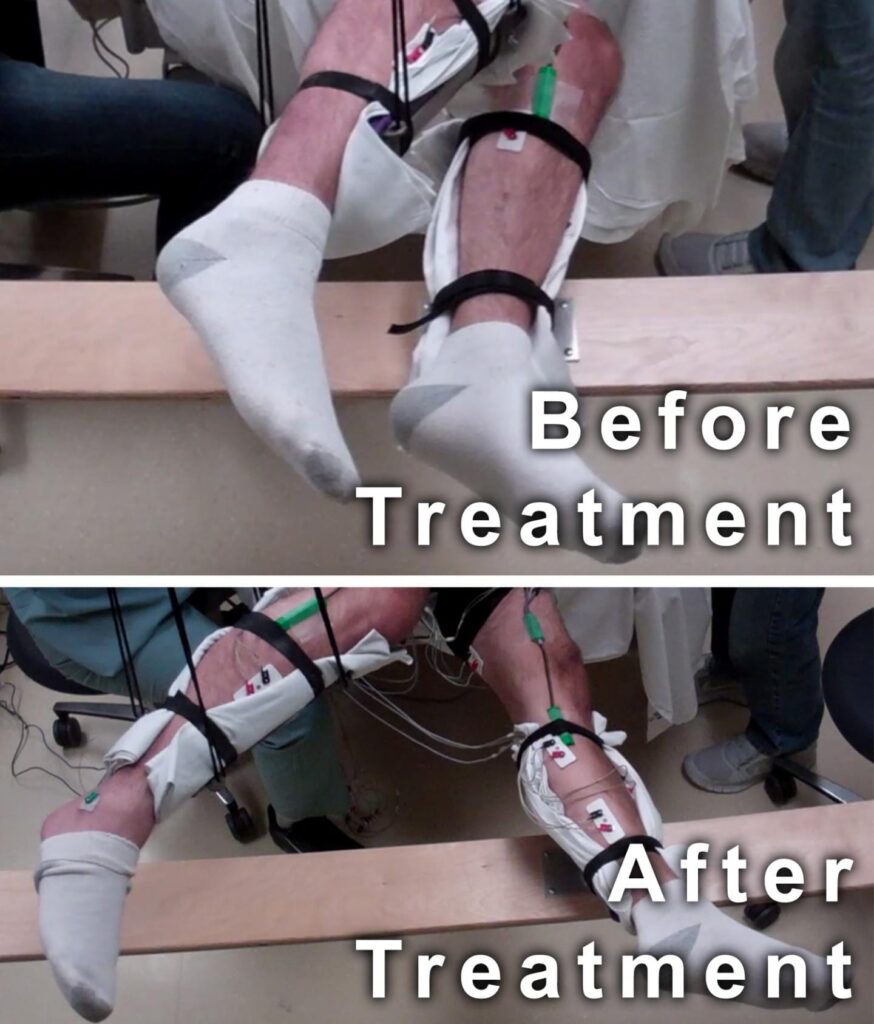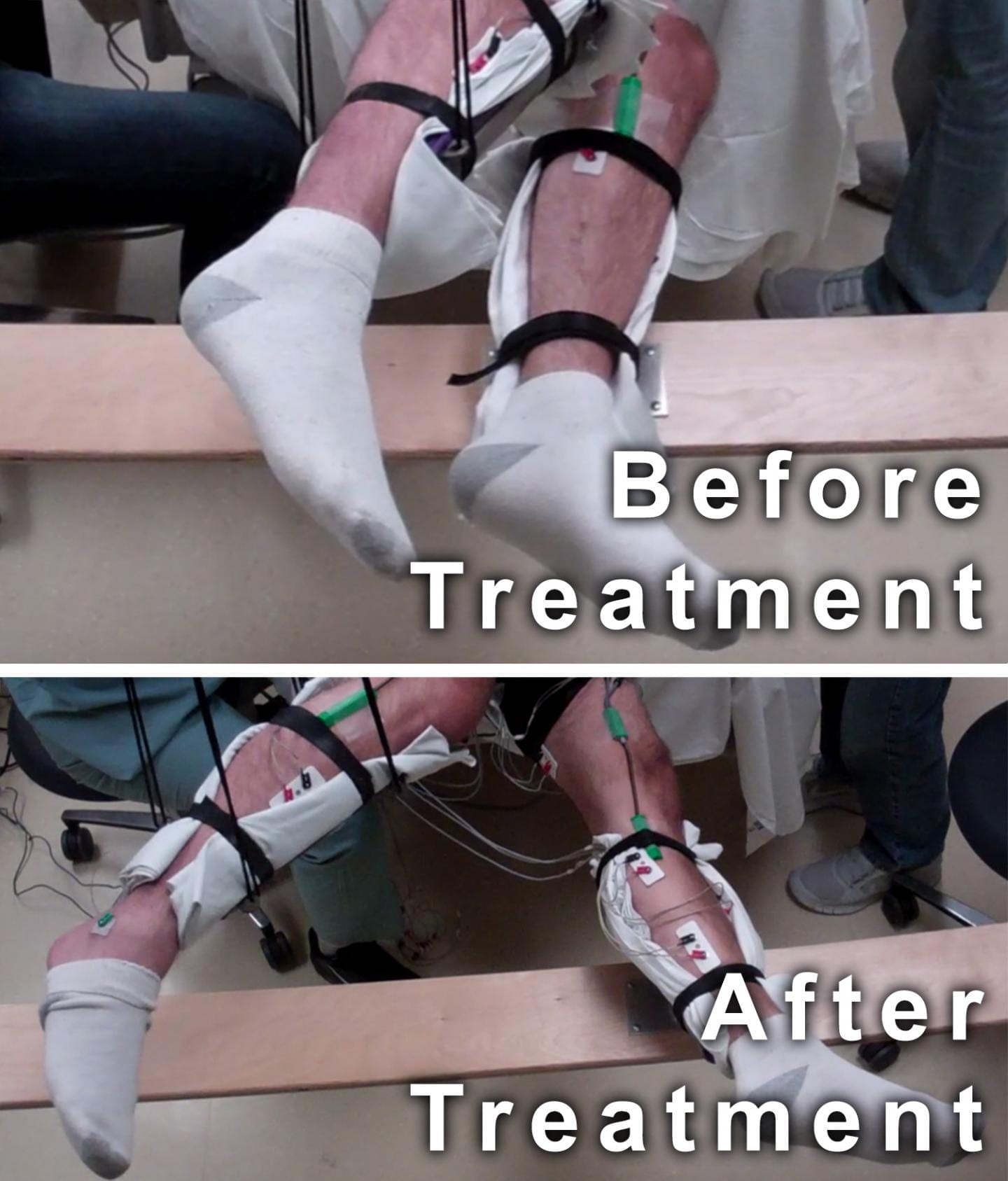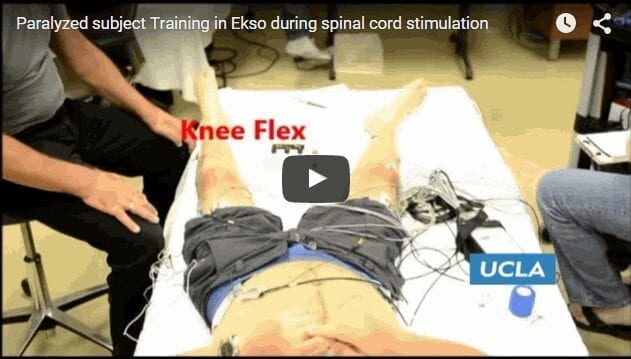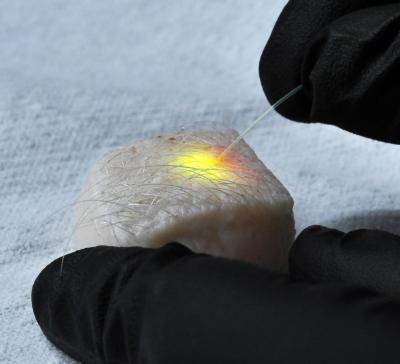
CREDIT
Edgerton lab/UCLA
After training, men move legs independently, without stimulation
Five men with complete motor paralysis were able to voluntarily generate step-like movements thanks to a new strategy that non-invasively delivers electrical stimulation to their spinal cords, according to a new study funded in part by the National Institutes of Health. The strategy, called transcutaneous stimulation, delivers electrical current to the spinal cord by way of electrodes strategically placed on the skin of the lower back. This expands to nine the number of completely paralyzed individuals who have achieved voluntary movement while receiving spinal stimulation, though this is the first time the stimulation was delivered non-invasively. Previously it was delivered via an electrical stimulation device surgically implanted on the spinal cord.
In the study, the men’s movements occurred while their legs were suspended in braces that hung from the ceiling, allowing them to move freely without resistance from gravity. Movement in this environment is not comparable to walking; nevertheless, the results signal significant progress towards the eventual goal of developing a therapy for a wide range of individuals with spinal cord injury.
“These encouraging results provide continued evidence that spinal cord injury may no longer mean a life-long sentence of paralysis and support the need for more research,” said Roderic Pettigrew, Ph.D., M.D., director of the National Institute of Biomedical Imaging and Bioengineering at NIH. “The potential to offer a life-changing therapy to patients without requiring surgery would be a major advance; it could greatly expand the number of individuals who might benefit from spinal stimulation. It’s a wonderful example of the power that comes from combining advances in basic biological research with technological innovation.”
The study was conducted by a team of researchers at the University of California, Los Angeles; University of California, San Francisco; and the Pavlov Institute, St. Petersburg, Russia. The team was led by V. Reggie Edgerton, Ph.D., a distinguished professor of integrative biology and physiology at UCLA and Yury Gerasimenko, Ph.D., director of the laboratory of movement physiology at Pavlov Institute and a researcher in UCLA’s Department of Integrative Biology and Physiology. They reported their results in the Journal of Neurotrauma.
In a study published a little over a year ago, Edgerton–along with Susan Harkema, Ph.D., and Claudia Angeli, Ph.D., from the University of Louisville, Kentucky–reported that four men with complete motor paralysis were able to generate some voluntary movements while receiving electrical stimulation to their spinal cords. The stimulation came from a device called an epidural stimulator that was surgically implanted on the surface of the men’s spinal cords. On the heels of that success, Edgerton and colleagues began developing a strategy for delivering stimulation to the spinal cord non-invasively, believing it could greatly expand the number of paralyzed individuals who could potentially benefit from spinal stimulation.
“There are a lot of individuals with spinal cord injury that have already gone through many surgeries and some of them might not be up to or capable of going through another,” said Edgerton. “The other potentially high impact is that this intervention could be close to one-tenth the cost of an implanted stimulator.”
During this most recent study, five men–each paralyzed for more than two years–underwent a series of 45 minute sessions, once a week, for approximately 18 weeks, to determine the effects of non-invasive electrical stimulation on their ability to move their legs.
In addition to stimulation, the men received several minutes of conditioning each session, during which their legs were moved manually for them in a step-like pattern. The goal of the conditioning was to assess whether physical training combined with electrical stimulation could enhance efforts to move voluntarily.
For the final four weeks of the study, the men were given the pharmacological drug buspirone, which mimics the action of serotonin and has been shown to induce locomotion in mice with spinal cord injuries. While receiving the stimulation, the men were instructed at different points to either try to move their legs or to remain passive.
At the initiation of the study, the men’s legs only moved when the stimulation was strong enough to generate involuntary step-like movements. However, when the men attempted to move their legs further while receiving stimulation, their range of movement significantly increased. After just four weeks of receiving stimulation and physical training, the men were able to double their range of motion when voluntarily moving their legs while receiving stimulation. The researchers suggest that this change was due to the ability of electrical stimulation to reawaken dormant connections that may exist between the brain and the spinal cord of patients with complete motor paralysis.
Surprisingly, by the end of the study, and following the addition of buspirone, the men were able to move their legs with no stimulation at all and their range of movement was–on average–the same as when they were moving while receiving stimulation.
“It’s as if we’ve reawakened some networks so that once the individuals learned how to use those networks, they become less dependent and even independent of the stimulation,” said Edgerton.
Read more: Paralyzed men move legs with new non-invasive spinal cord stimulation
The Latest on: Non-invasive spinal cord stimulation
[google_news title=”” keyword=”Non-invasive spinal cord stimulation” num_posts=”10″ blurb_length=”0″ show_thumb=”left”]
via Google News
The Latest on: Non-invasive spinal cord stimulation
- Cambridge’s Flexible Implants Promise New Hope for Paralysis Patientson May 8, 2024 at 11:00 am
A tiny, flexible electronic device that wraps around the spinal cord could represent a new approach to the treatment of spinal injuries, which can cause profound disability and paralysis. A team of ...
- Spinal Cord Compression: An Obstructive Oncologic Emergencyon May 3, 2024 at 5:01 pm
Spinal cord compression can also occur through direct tumor extension, which is frequently seen in non-Hodgkin's lymphoma. In such cases, there is direct extension of a paraspinal mass through the ...
- Bone Growth Stimulator Market Report on the Untapped Growth Opportunities in the Industryon April 22, 2024 at 1:08 pm
The Bone Growth Stimulator Market Size is valued at 1161.47 Million in 2023 and is predicted to reach 1967.46 Million by the year 2031 at a 7.04 % CAGR during the forecast period ...
- Evidence doesn’t support spinal cord stimulators for chronic back pain – and they could cause harmon April 9, 2024 at 10:17 pm
Early models required an external generator and invasive surgery to implant ... They compared spinal cord stimulation to non-surgical treatments or placebo devices (for example, deactivated ...
- Evidence Doesn't Support Spinal Cord Stimulators For Chronic Back Pain And They Could Cause Harmon April 9, 2024 at 7:05 pm
Early models required an external generator and invasive surgery to implant ... They compared spinal cord stimulation to non-surgical treatments or placebo devices (for example, deactivated ...
- Evidence doesn't support spinal cord stimulators for chronic back pain—and they could cause harm, say researcherson April 9, 2024 at 5:00 pm
Early models required an external generator and invasive surgery to implant ... They compared spinal cord stimulation to non-surgical treatments or placebo devices (for example, deactivated ...
- Study: Spinal cord stimulation a potential new way to treat depressionon December 20, 2023 at 1:13 pm
More information: Francisco Romo-Nava et al, Effect of non-invasive spinal cord stimulation in unmedicated adults with major depressive disorder: a pilot randomized controlled trial and induced ...
- Jeffrey M. Epstein M.D. Neurosurgery and Pain Management Specialiston April 10, 2023 at 10:49 pm
from both a surgical and non-surgical vantage point. Having lectured both nationally and internationally in the use of spinal cord stimulation for the management of spinal pain, I am frequently ...
- Spinal Cordon August 8, 2020 at 10:42 pm
non-invasive diet- or supplement-based treatment option for improving the health and quality of life for persons with SCI. This study is the site-specific research project of the UAB Spinal Cord ...
via Bing News











